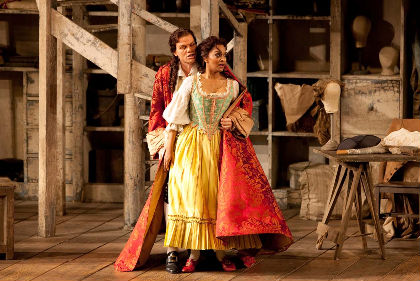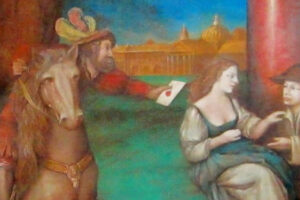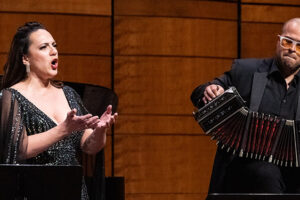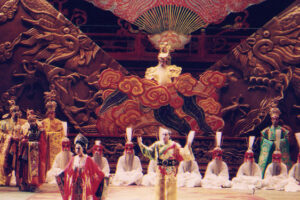
Our JJ‘s review of the Met’s revival of Le nozze di Figaro didn’t make it into today’s New York Post for reasons that you should be able to figure out once you’ve read the piece. At the suggestion of his editor, La Cieca is publishing it here.

Bo Skovhus and Danielle de Niese in an "unseen" moment from the Met's "Figaro." Photo by Marty Sohl.
A revival of Le nozze di Figaro at the Metropolitan Opera puts first things first, boasting a breezy, uncluttered performance of Mozart’s ravishing score.
The sexy comedy unfolds on the wedding day of Figaro, ex-barber of
Seville (John Relyea) to lady’s maid Susanna (Danielle de Niese), who is busy fending off their lecherous boss Count Almaviva (Bo Skovhus).
Misreading the curtain time robbed me of the first act on September 26, but in the remaining three, conductor Dan Ettinger coaxed elegant woodwind sound and crystalline string playing from the Met’s luxe orchestra.
Rising to his level was Isabel Leonard in the cross-dressing role of the love-struck boy Cherubino. Her shimmering mezzo-soprano, deadpan acting and sleek styling of the song “Voi che sapete” are incentive enough to return for her complete performance.
Soprano de Niese just released a solo CD, but ironically her voice is the least interesting thing about her. A knockout with dark flashing eyes, she puts over the Lorenzo da Ponte libretto with such verve it’s easy to follow the story even if you don’t speak Italian. But her suave aria “Deh vieni” turned bumpy and coarse.
Emma Bell as the heartbroken Countess won the night’s longest ovation after the aria “Dove sono,” even though her blurry soprano veered out of tune as she mushmouthed the poetic lyrics to a muddle of “uh” and “oo” noises.
Among the men, healthy-voiced bass Reylea won the girl, but baritone Shovhus stole the show as the aristocratic player hilariously lacking in skills, a real Don Wannabee. Veteran British tenor Philip Langridge etched a cameo as bitchy music teacher Don Basilio.
Of Jonathan Miller‘s 1998 production, little detail remains besides a silent Almaviva daughter who pops in occasionally to witness her dad’s misbehavior. Sets by Peter J. Davison and costumes by James Acheson drag the bubbly comedy to a level of beige good taste, like a faded print of a Merchant Ivory film. — James Jorden
























Comments